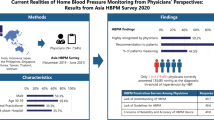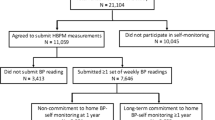Abstract
The objective of this study was to survey hypertensive patients' response to, requirement for and training in self-blood pressure monitoring (SBPM). A total of 222 hypertensives were invited to complete a questionnaire even when not participating in the project. Questions supplied information on demographics, monitoring frequency, convenience of attending the surgery, monitor ownership and preference for and ease of self-monitoring. Comments supplied qualitative data. Training group questionnaires supplied similar data as well as SBPM data before and after training. Of 133 respondents, a higher educated, younger, wider age range wanted to participate (76; 57.2%) and tended to self-monitor. However, only an increase in further education (FE) was associated with an increased probability of participation and inclination to self-monitor in the multivariate analyses. A positive relationship exists between age and frequency in both groups. About a sixth of respondents own monitors and ownership is correlated to FE. Although most patients found it convenient to visit the surgery, the percentage finding it convenient was lower in patients attending training sessions than in the original survey, possibly indicating that independence is important for SBPM. Younger, higher-educated patients tended to self-monitor although FE was again the significant factor. Training increased preference for the idea of SBPM, prospective monitor ownership (64.8% of non-owners) and self-monitoring intention (76.1%). Patients found recording card listed cardiovascular disease (CVD) risks valuable and 69.6% (32) wanted to establish a support group. Comments and interviews indicated haphazard knowledge, routines and uncertainty about SBPM. A standardised procedure including patient assessment, SBPM protocol and lifestyle education is needed for SBPM to be successful.
This is a preview of subscription content, access via your institution
Access options
Subscribe to this journal
Receive 12 digital issues and online access to articles
$119.00 per year
only $9.92 per issue
Buy this article
- Purchase on Springer Link
- Instant access to full article PDF
Prices may be subject to local taxes which are calculated during checkout

Similar content being viewed by others
References
Pieper JA . Management of coronary heart disease risk factors and progression with calcium blockers. Pharmacotherapy 2001; 21: 195S–208S.
Ruilope LM, Schiffrin EL . Blood pressure control and benefits of antihypertensive therapy: does it make a difference which agents we use? Hypertension 2001; 38: 537–542.
Department of Health. Saving lives: our healthier nation. Department of Health 1999; pp 72–73.
PROGRESS Collaborative Group. Randomised trial of a perindopril-based blood-pressure-lowering regimen among 6105 individuals with previous stroke or transient ischaemic attack. Lancet 2001; 358: 1033–1041.
Mensah GA . Refining strategies for the prevention and control of hypertension and related complications. Ethn Dis 1999; 9: 327–332.
Department of Health. Saving lives: our healthier nation Department of Health 1999; pp76–77.
Department of Health. Patient and public involvement in the new NHS. Department of Health Report 1999. Also found at:http://www.doh.gov.uk/pub/docs/doh/ppinvolvement.pdf.
Jula A, Puukka P, Karanko, . Multiple clinic and home blood pressure measurements versus ambulatory blood pressure monitoring. Hypertension 1999; 34: 261–266.
Comas A et al. The evaluation of the hypertensive patient via self-measured blood pressure at home. Atten Primaria 1998; 22: 142–148.
Ramsay LE et al. Guidelines for management of hypertension: report of the third working party of the British Hypertension Society. J Hum Hypertens 1999; 13: 569–592.
Torres Jimenez J et al. Variations in the prevalence and patient profile of white-coat syndrome, according to its definition using self-measurement of blood pressure at home. Atten Primaria 2001; 28: 234–240.
Balas EA, Iakovidis I . Distance technologies for patient monitoring. BMJ 1999; 319: 1309
Department of Health. National Service Frameworks Coronary Heart Disease Modern Standards and Service Models. Department of Health, 2000.
Hippisley-Cox J, Pringle M . General practice workload implications of the national service framework for coronary heart disease: cross sectional study. BMJ 2001; 323: 269–270.
Stergiou GS et al. Home monitoring of blood pressure: limited value in general practice. J Hum Hypertens 1996; 10: 219–223.
Merrick RD et al. Factors influencing the accuracy of home blood pressure measurement. South Med J 1997; 90: 1110–1114.
Johnson KA, Partsch DJ, Rippole LL, McVey DM . Reliability of self-reported blood pressure measurements. Arch Intern Med 1999; 159: 2689–2693.
Jeck T et al. Performing self-measurement of blood pressure: a patient survey. Schweiz Rundsch Med Prax 1991; 80: 456–461.
Bailey B, Carney SL, Gillies AA, Smith AJ . Antihypertensive drug treatment: a comparison of usual care with self blood pressure measurement. J Hum Hypertens 1999; 13: 147–150.
Nordmann A et al. Reliability of patients measuring blood pressure at home: prospective observational study. BMJ 1999; 319: 1172
Birkett NJ et al. Self-measurement of blood pressure: issues related to the training of patients. Canadian Coalition for High Blood Pressure Prevention and Control. Can J Cardiol 1995; 11: 23H–27H.
Tyson M . Blood pressure self-monitoring evaluation. July 2001, 69pp
Moser C, Kalton G . Survey Methods in Social Investigation, 2nd edn. Dartmouth Publishing Company Limited, Hants, UK, 1979.
Lee J, Chia KS . Estimation of prevalence rate ratios for cross sectional data: an example in occupational epidemiology. Br J Ind Med 1993; 50: 861–864.
Jo I et al. Prevalence, awareness, treatment, control and risk factors of hypertension in Korea: the Ansan study. J Hypertens 2001; 19: 1523–1532.
Ibrahim MM et al. Hypertension prevalence, awareness, treatment and control in Egypt. Results from the Egyptian National Hypertension Project (NHP). NMP Investigative Team. Hypertension 1995; 26: 886–890.
Sonmez HM et al. The epidemiology of elevated blood pressure as an estimate for hypertension in Aydin, Turkey. J Hum Hypertens 1999; 13: 399–404.
Franklin SS et al. Does the relation of blood pressure to coronary heart disease risk change with aging?. Circulation 2001; 103: 1245.
O'Brien E et al. Blood pressure measuring devices: recommendations of the European Society of Hypertension. BMJ 2001; 322: 531–536.
Hanon O et al. Blood pressure self-monitoring contributes to improved patient education among hypertensive subjects. Arch Mal Coeur Vaiss 2001; 94: 879–883.
Le Pailleur C et al. Talking effect and ‘white coat’ effect in hypertensive patients: physical effort or emotional content?. Behav Med 2001; 26: 149–157.
Myers MG, Meglis G, Polemidiotis G . The impact of physician vs automated blood pressure readings on office-induced hypertension. J Hum Hypertens 1997; 11: 491–493.
Aivazyan TA et al. Psychophysiological interrelations and reactivity characteristics in hypertensives. Health Psychol 1988; 7(Suppl): 139–144.
Un S, Mengden T, Vetter H . Your patient self-monitors his blood pressure. Other limit values are applicable. MMW Fortschr Med 2000; 142: 28–30.
Mengden T et al. User procedure for self-measurement of blood pressure. First International Consensus Conference on Self Blood Pressure Measurement. Blood Press Monit 2000; 5: 111–129.
Medical Devices Agency. Blood Pressure Measurement Devices—Mercury and Non-mercury, Device bulletin MDA DG2000 (03: Department of Health 2000)
Kannel WB et al. The Framingham Study: ITS 50-year legacy and future promise. J Atheroscler Thromb 2000; 6: 60–66.
Paganini-Hill A, Perez Barreto M . Stroke risk in older men and women: aspirin, estrogen, exercise, vitamins, and other factors. J Gend Specif Med 2001; 4: 18–28.
Butler RN et al. Hypertension: setting new goals for lower readings. Geriatrics 1999; 54: 20–21, 25–26, 29–30.
Kjellgren KI, Svensson S, Ahlner J, Saljo R . Hypertensive patients' knowledge of high blood pressure. Scand J Prim Health Care 1997; 15: 188–192.
Trilling JS, Froom J . The urgent need to improve hypertension care. Arch Fam Med 2000; 9: 794–801.
Bortolotto LA et al. Feasibility and importance of self-monitoring in patients over 75 years old. Arch Mal Coeur Vaiss 1999; 92: 1159–1162.
Ashida T et al. Profiles of patients who control the doses of their antihypertensive drugs by self-monitoring of home blood pressure. Hypertens Res 2001; 24: 203–207.
White WB et al. Task force VI: self-monitoring of the blood pressure. Blood Press Monit 1999; 4: 343–351.
Veglio F et al. Ambulatory blood pressure monitoring and clinical characteristics of the true and white-coat resistant hypertension. Clin Exp Hypertens 2001; 23: 203–211.
Addison C, Varney S, Coats A . The use of ambulatory blood pressure monitoring in managing hypertension according to different treatment guidelines. J Hum Hypertens 2001; 15: 535–538.
Jeck T et al. Self measurement of blood pressure: patient education. Schweiz Rundsch Med Prax 1989; 78: 1346–1349.
Brook RD . Home blood pressure: accuracy is independent of monitoring schedules. Am J Hypertens 2000; 13: 625–631.
Stanton JA, Lowenthatl DT . The evidence for lifestyle modification in lowering blood pressure in the elderly. Am J Geriatr Cardiol 2000; 9: 27–33.
Maitland-van der Zee et al. The association between antihypertensive drug therapies and plasma lipid levels in the general population. J Hum Hypertens 2001; 15: 701–705.
Tomaszewski M et al. Some aspects of non-pharmacologic treatment of hypertension. Przegl Lek 1999; 56: 579–583.
Boulware LE et al. An evidence-based review of patient-centered behavioral interventions for hypertension(1). Am J Prev Med 2001; 21: 221–232.
Jacob RG et al. Relaxation therapy for hypertension: setting-specific effects. Psychosom Med 1992; 54: 87–101.
Ashida T et al. Relationship between home blood pressure measurement and medication compliance and name recognition of antihypertensive drugs. Hypertens Res 2000; 23: 21–24.
Reid CM, Maher T, Jennings GL . Heart Project Steering Committee. Substituting lifestyle management for pharmacological control of blood pressure: a pilot study in Australian general practice. Blood Press 2000; 9: 267–274.
Reilly JJ, Dorosty AR . Epidemic of obesity in UK children. Lancet 1999; 354: 1874–1875.
Acknowledgements
We are grateful to Mr Colin Penney for being the project demonstrator, the staff at Hadfield Medical Centre, 82 Brosscroft, Hadfield, Glossop, Derbyshire, UK, for their help and the project location, HMC patients for their time and patience and Glossopdale Primary Care Sub-Group and West Pennine Health Authority for funding the project.
Author information
Authors and Affiliations
Corresponding author
Rights and permissions
About this article
Cite this article
Tyson, M., McElduff, P. Self-blood-pressure monitoring—a questionnaire study: response, requirement, training, support-group popularity and recommendations. J Hum Hypertens 17, 51–61 (2003). https://doi.org/10.1038/sj.jhh.1001510
Received:
Published:
Issue Date:
DOI: https://doi.org/10.1038/sj.jhh.1001510
Keywords
This article is cited by
-
Factors influencing home blood pressure monitor ownership in a large clinical trial
Journal of Human Hypertension (2022)
-
Use of home sphygmomanometers in Turkey: a nation-wide survey
Hypertension Research (2012)
-
Appraisal of the knowledge of hypertensive patients and assessment of the role of the pharmacists in the management of hypertension: results of a regional survey
Journal of Human Hypertension (2005)



